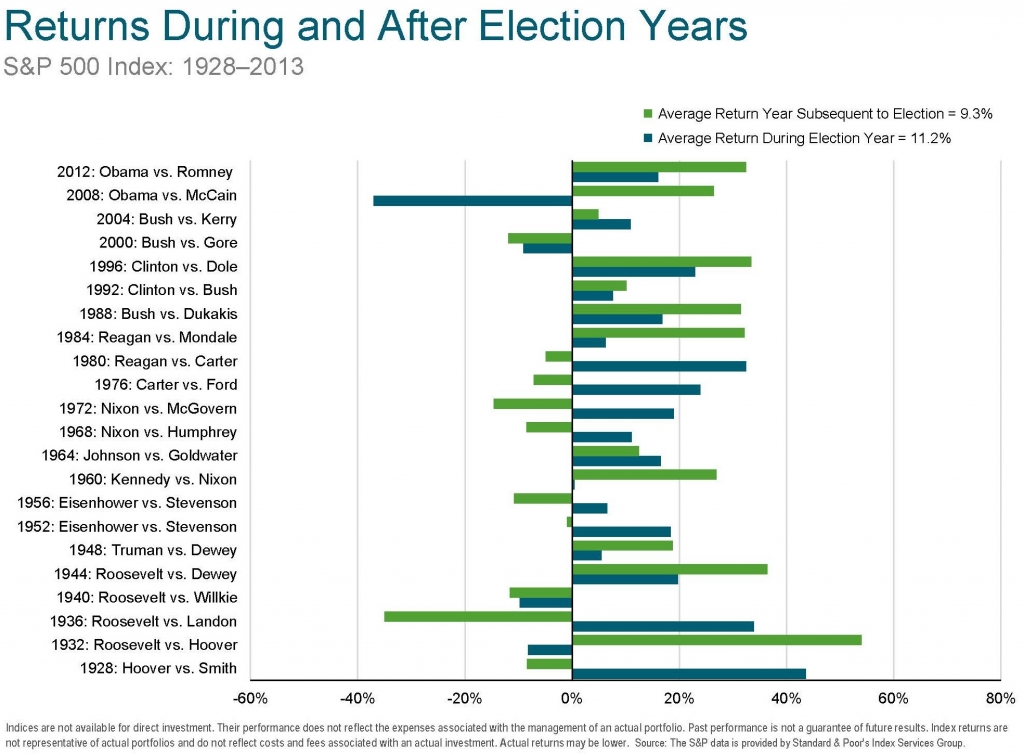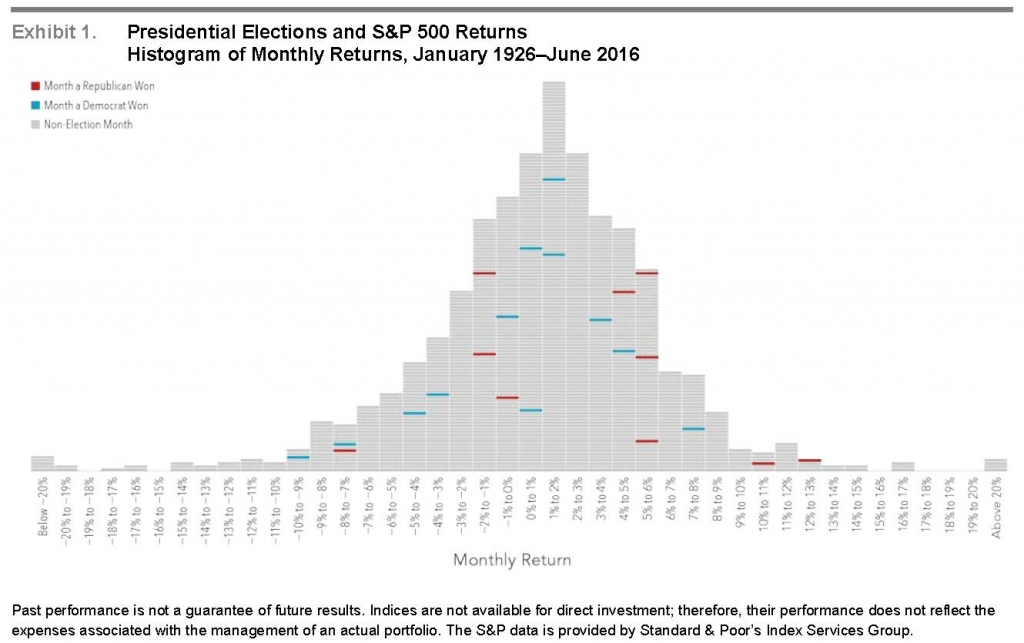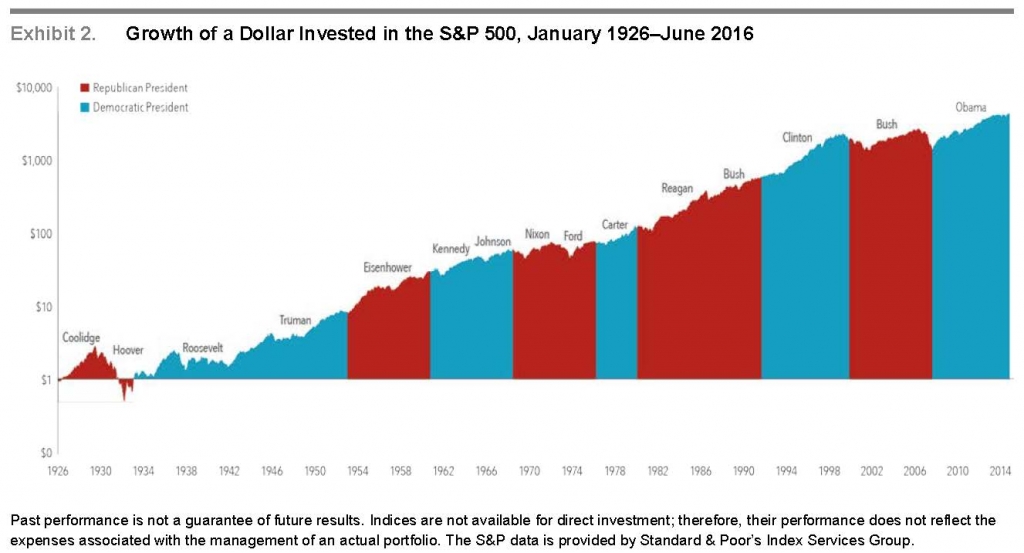Presidential Elections and the Stock Market
Next month, Americans will head to the polls to elect the next president of the United States.
While the outcome is unknown, one thing is for certain: There will be a steady stream of opinions from pundits and prognosticators about how the election will impact the stock market. As we explain below, investors would be well‑served to avoid the temptation to make significant changes to a long‑term investment plan based upon these sorts of predictions.
Election Expectations Baked into Stock Prices
Trying to outguess the market is normally a losing game. Current market prices offer an up-to-the-minute snapshot of the aggregate expectations of market participants. This includes expectations about the outcome and impact of elections. While unanticipated future events—surprises relative to those expectations—may trigger price changes in the future, the nature of these surprises cannot be known by investors today. As a result, it is difficult, if not impossible, to systematically benefit from trying to identify mispriced securities. This suggests it is unlikely that investors can gain an edge by attempting to predict what will happen to the stock market after a presidential election.
Returns During and After Election Years
On average, market returns have been positive in both election years and the year subsequent to elections. The chart below shows average annual returns of the S&P 500 during an election year and the year subsequent to an election from 1928 to 2013. Over these periods, the S&P 500 returned 11.2% and 9.3%, respectively.

The chart illustrates that the annual returns surrounding an election are similar to the long-term returns of the S&P 500. This suggests that market expectations associated with election outcomes are embedded in security prices.
This can also be seen with the volatility and uncertainty that occurs when election outcomes are different from market expectations, as seen early this year with the Brexit vote. Leading up to the vote, the market predicted a “no” vote, but reacted strongly when the citizens of the United Kingdom voted in favor of leaving the European Union.
If the candidate or party trailing in the polls wins unexpectedly, the market must reprice the outcome, which results in volatility.
A similar risk story can be applied to the lower average returns following an election year. Some argue that the uncertainty surrounding a new administration’s policies leads to this result.
Short-term Trading and Presidential Election Results
Exhibit 1 shows the frequency of monthly returns (expressed in 1% increments) for the S&P 500 Index from January 1926 to June 2016. Each horizontal dash represents one month, and each vertical bar shows the cumulative number of months for which returns were within a given 1% range (e.g., the tallest bar shows all months where returns were between 1% and 2%). The blue and red horizontal lines represent months during which a presidential election was held. Red corresponds with a resulting win for the Republican Party and blue with a win for the Democratic Party. This graphic illustrates that election month returns were well within the typical range of returns, regardless of which party won the election.

Long-Term Investing: Bulls & Bears ≠ Donkeys & Elephants
Predictions about presidential elections and the stock market often focus on which party or candidate will be “better for the market” over the long run. Exhibit 2 shows the growth of one dollar invested in the S&P 500 Index over nine decades and 15 presidencies (from Coolidge to Obama). This data does not suggest an obvious pattern of long-term stock market performance based upon which party holds the Oval Office. The key takeaway here is that over the long run, the market has provided substantial returns regardless of who controlled the executive branch.

Vote for the Long Term
Equity markets can help investors grow their assets, but investing is a long-term endeavor. Trying to make investment decisions based upon the outcome of presidential elections is unlikely to result in reliable excess returns for investors.
At best, any positive outcome based on such a strategy will likely be the result of random luck. At worst, it can lead to costly mistakes. Accordingly, there is a strong case for investors to rely on patience and portfolio structure, rather than trying to outguess the market, in order to pursue investment returns.1
TAGStone remains committed to helping its clients have a good investment experience through this tumultuous election cycle. Its investment strategy is designed to capture factors of higher return that can present themselves at any time, including during this uncertain time. This is why, with your investment portfolio, we ask you to vote for the long term.
[1] Source: Dimensional Fund Advisors LP, October 2016.
Past performance does not guarantee future results. All investments include risk and have the potential for loss as well as gain.
Data sources for returns and standard statistical data are provided by the sources referenced and are based on data obtained from recognized statistical services or other sources we believe to be reliable. However, some or all information has not been verified prior to the analysis, and we do not make any representations as to its accuracy or completeness. Any analysis nonfactual in nature constitutes only current opinions, which are subject to change. Benchmarks or indices are included for information purposes only to reflect the current market environment; no index is a directly tradable investment. There may be instances when consultant opinions regarding any fundamental or quantitative analysis do not agree.
The commentary contained herein has been compiled by W. Reid Culp, III from sources provided by TAGStone Capital, Capital Directions, DFA, Vanguard, Morningstar, as well as commentary provided by Mr. Culp, personally, and information independently obtained by Mr. Culp. The pronoun “we,” as used herein, references collectively the sources noted above.
TAGStone Capital, Inc. provides this update to convey general information about market conditions and not for the purpose of providing investment advice. Investment in any of the companies or sectors mentioned herein may not be appropriate for you. You should consult your advisor from TAGStone for investment advice regarding your own situation.
